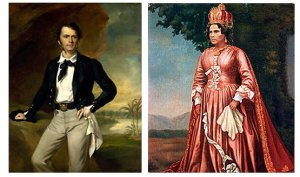Simanaitis Says
On cars, old, new and future; science & technology; vintage airplanes, computer flight simulation of them; Sherlockiana; our English language; travel; and other stuff
CELEBRATING SIR HARRY FLASHMAN
IN THESE complex days of heroes and antiheroes, it’s fun to celebrate a downright scoundrel. Not just any downright scoundrel, but Sir Harry Paget Flashman, VC KCB KCIE.
Sir Harry first appeared as a bully in Thomas Hughes’ Tom Brown’s School Days, an influential (if now highly unread) Victorian novel of the Goodbye, Mr. Chips/St. Trinian’s/Hogswart genre. More than a century after this book’s 1856 publication, Scottish author George MacDonald Fraser discovered The Flashman Papers, memoirs of our hero/antihero.
In Flashman, 11 later books and a brief appearance in Fraser’s Mr. American, Sir Harry gets involved in the 19th century’s most famous events, often in the most infamous ways. (Did his flatulence initiate the Charge of the Light Brigade? Who actually killed General Custer at Little Big Horn?)
I recommend all 13 books. Here are several favorites.

Flashman: A Novel by George MacDonald Fraser, Barrie & Jenkins, 1969, the first in 12 of The Flashman Papers.
Flashman covers Harry (not yet knighted) in his 1839 – 1842 adventures in India and Afghanistan. At the onset, he admits to three outstanding skills: horsemanship, foreign languages and fornication.
During the 1842 Kabul Retreat, Harry is seen as the sole survivor, a hero wrapped in the Union Jack. In fact, in an exercise of unparalleled cowardice, he intended to surrender the Colours, not defend them.

Flashman’s Lady by George MacDonald Fraser, Barrie & Jenkins, 1977.
Flashman’s Lady, 1842 – 1845, contains excerpts from the diary of Elspeth, Harry’s wife whom we met in the first memoir. She’s a real piece of work. On a voyage to Singapore, Elspeth is kidnapped by Sulieman Usman, notorious pirate prince based in Borneo.

James, Rajah of Sarawak, and Queen Ranavalona I of Madagascar are two of Harry’s real-life historical companions.
Harry reluctantly gives chase with the help of James Brooke, an actual personage who set himself up as James, Rajah of Sarawak, reigning 1842 – 1868. Harry’s award of a Victoria Cross, knighthood and eventual rescue of Elspeth (and hers of him) are complicated by his affair with Ranavalona I, Queen of Madagascar, reigning 1828 – 1861, and another actual person appearing in The Flashman Papers.
If ever there was one, Harry and Elspeth are a matched pair.

Flashman and the Tiger by George MacDonald Fraser, HarperCollins, 1999.
The tiger of Flashman and the Tiger is “Tiger Jack” Moran, whom others may know as Colonel Sebastian Moran, devoted sportsman and dead shot with a rifle. According to none other than Sherlock Holmes, Moran is “the second most dangerous man in London.”
Sir Harry runs with Tiger Jack after the 1879 Battle of Isandlwana, a major encounter in South Africa’s Anglo-Zulu war. Neither of them shows particular bravery in this battle, known for state-of-the-art-armed Brits being vastly outnumbered and overwhelmed by Zulu warriors.
Again, a real personage makes a cameo appearance in The Flashman Papers: Sherlock Holmes mistakes Sir Harry for a tramp, while the police arrest Moran. See Dr. John H. Watson’s chronical, “The Adventure of the Empty House.”

George MacDonald Fraser, OBE, FRSL, 1925 – 2008, British author of historical novels, non-fiction, screenplays and custodian of The Flashman Papers.
Each of The Flashman Papers has scads of footnotes assembled by Fraser. He amplifies on the historical events, with only occasional corrections of Sir Harry’s typically self-serving analyses.
Together with those described here, others in the series are Royal Flash (Flashman),1970; Flash for Freedom! (Flashman)
, 1971; Flashman at the Charge
, 1973; Flashman in the Great Game: A Novel
, 1975; Flashman and the Redskins
, 1982; Flashman and the Dragon, 1985; Flashman and the Mountain of Light
, 1990; Flashman and the Angel of the Lord
, 1994; and Flashman on the March (Flashman Papers)
, 2005.
They’re great ways to celebrate the less than heroic in us all. ds
© Dennis Simanaitis, SimanaitisSays.com, 2014


As I recall (I must have read one or another of the books) while he was at college he engaged in a famous duel in which he rigged it so that he could not be harmed, then turned his pistol aside to fire it harmlessly, supposedly to demonstrate his bravery. His shot hit something in such a way as to appear that he had aimed at it, thus inadvertantly also gaining him the reputation as a crack shot. Wish I knew which book that was, and where it is.
It’s wonderfully typical of Sir Harry to have done this. I delight too in his wife Elspeth being of similar character. A real pair.
By the way, the Flashman Papers Google entry gives a summary of each book.
The duel was in the first book, Flashman. Witnesses at the event stated that he had ‘deloped’
Er…he wasn’t Scottish. George Macdonald Fraser was from Carlisle, Cumbria.
Thanks for this. Correction coming.